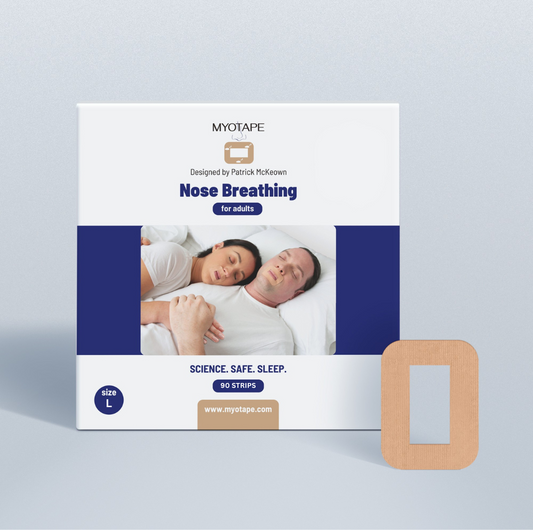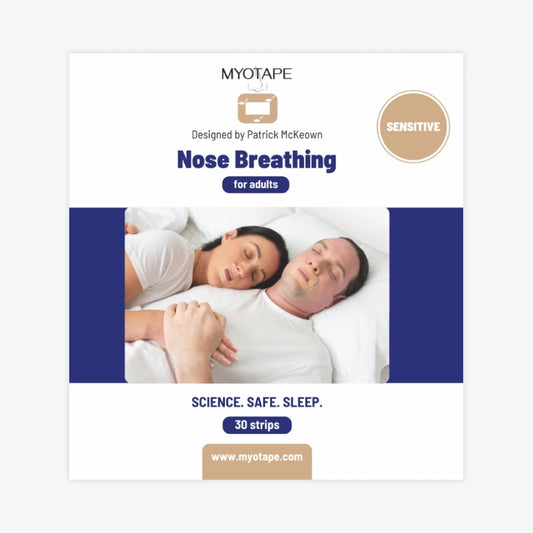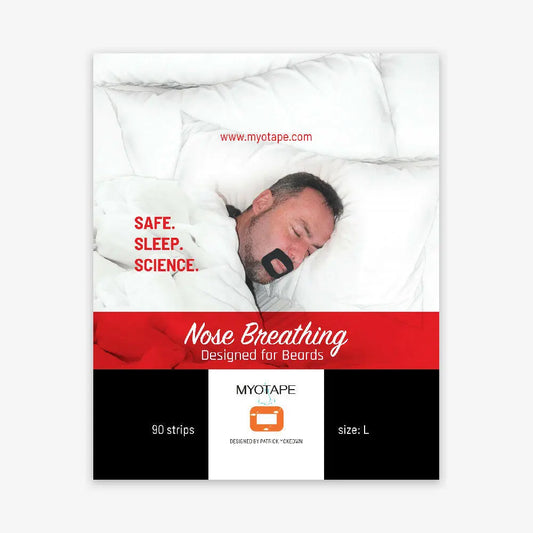Better sleep, fresher breath, and more energy throughout the day; these are just some of the benefits you can enjoy when you train yourself to stop mouth breathing.
Still, for many people, mouth breathing is an overlooked habit that can seriously impact health and daily life. Training yourself to stop mouth breathing can bring real and noticeable improvements every day.
In this article, you will learn why mouth breathing happens, why it is important to address, and most importantly, simple and effective methods to retrain your breathing during the day and at night, as well as how tools like MyoTape can help support your progress.
Let’s begin by looking at why mouth breathing is so common.
Why Do People Mouth Breathe?
Mouth breathing means taking in air through your mouth instead of your nose. Many people do not even realize they do it, but it can start in childhood and continue into adulthood.
Studies indicate that as many as 60% of children and approximately 17% of adults habitually breathe through their mouths.
Common reasons for mouth breathing, especially in kids include:
- Nasal blockage, such as from allergies, sinus infections, or a deviated septum
- Enlarged tonsils or adenoids, which can block the nasal passages
- Structural issues like a narrow jaw or tongue-tie, which sometimes require surgery to fix
- Habits formed in childhood, like thumb sucking or frequent bottle-feeding
- Environmental factors, such as dry air or poor ventilation, make nasal breathing more difficult.
Understanding the cause is the first step if you want to learn how to train yourself not to be a mouth breather. Always consult with your doctor first to find out why.
Why Mouth Breathing Is Bad

Mouth breathing can lead to several health problems. Unlike your nose, your mouth does not filter, warm, or humidify the air you breathe in.
This allows more dust and allergens to reach your lungs and throat, making irritation and illness more likely. It also dries out your mouth, which can cause bad breath, tooth decay, and gum disease.
Studies show that mouth breathers have higher levels of dental plaque and more harmful bacteria, thereby increasing their risk of dental issues.
Mouth breathing is also linked to poor sleep and insomnia. When you sleep with your mouth open, your airway is more likely to collapse, leading to snoring and sleep disruptions.
Nose breathing helps keep your airway open, supports deeper sleep, and lowers the risk of sleep apnea.
Research indicates that individuals who breathe through their mouths at night are more likely to wake up tired and experience more sleep disturbances. Another study found that nasal congestion can lead to increased fatigue and slower cognitive function.
Mouth breathing can also exacerbate nasal congestion, creating a cycle that is difficult to break. The more you breathe through your mouth, the more blocked your nose can become.
If you are unsure, you can look out for signs that you might be a mouth breather.
What Happens When You Stop Mouth Breathing?
When you stop mouth breathing, you are likely to sleep better, have more energy, and enjoy better focus during the day. Your oral health may improve, with less dry mouth and fresher breath.
Nose breathing increases oxygen uptake, helps your immune system, and supports overall health. Studies support that switching to nose breathing can improve sleep quality, mental clarity, and even help prevent dental and respiratory problems.
Furthermore, when you start breathing through your nose, your body produces more nitric oxide, a gas released in the nasal passages that helps improve oxygen uptake, supports your immune system, and promotes better overall health.
It is clear that learning how to train yourself to stop mouth breathing can make a real difference in your daily life.
Next, you will learn practical steps to help you stop mouth breathing and start enjoying these benefits.
How to Train Yourself to Stop Mouth Breathing
Here are the tips that can help train you to stop mouth breathing and switch to nasal breathing:
1. Make nose breathing your new habit
The first step in retraining your breathing is to make a conscious effort to use your nose for every breath, whether you are at rest, working, or moving around.
Nasal breathing is essential because it filters, warms, and humidifies the air, supporting better oxygen uptake and protecting your airways. Remind yourself throughout the day to keep your mouth closed, especially during light activities and exercise.
This daily practice helps reinforce nasal breathing as your default pattern, making it easier to maintain even when you are not thinking about it.
2. Use MyoTape to encourage mouth closure
MyoTape is a gentle adhesive tape that can help you break the mouth breathing habit by bringing your lips together without fully sealing your mouth.
Start by wearing MyoTape for short periods during the day, such as while reading or watching TV, to get used to the feeling.
As you become more comfortable, try wearing it at night. MyoTape provides a physical reminder to keep your mouth closed, making it easier to switch to nasal breathing both during the day and at night.
3. Practice Buteyko Breathing exercises
The Buteyko Method is a set of scientifically-backed breathing exercises designed to retrain your body to breathe through your nose. These exercises focus on slow, gentle nasal breathing and breath holds, which help clear nasal congestion and make nasal breathing feel more natural.
Practicing the Buteyko Method regularly can reduce your urge to mouth breathe, improve breathing efficiency, and support better sleep and energy levels.
4. Perform nose-unblocking exercises for immediate relief
If nasal congestion makes nose breathing difficult, try this simple Buteyko nose-unblocking exercise:
- Sit upright in a chair.
- Breathe out gently through your nose (or mouth if needed).
- Pinch your nose closed and hold your breath.
- While holding, gently nod your head or sway your body until you feel a strong need for air.
- Release your nose and breathe in softly through your nose, keeping your mouth closed.
- Focus on calm, gentle breathing and repeat several times as needed.
This technique can quickly clear your nasal passages and help you stick with nasal breathing.
5. Adopt the correct tongue resting posture
Proper tongue posture is a valuable tip for maintaining an open airway and promoting nasal breathing. Train yourself to rest most of your tongue gently against the roof of your mouth, without touching your top front teeth.
This position helps maintain an open airway where the back of the mouth meets the throat, making it easier to breathe comfortably through your nose.
Practicing this tongue posture throughout the day will reinforce nasal breathing and help prevent your mouth from falling open.
6. Stay hydrated to support clear nasal passages
Drinking enough water each day is crucial for keeping your nasal passages moist and less prone to congestion.
Dehydration can dry out the lining of your nose, making it harder to breathe nasally and increasing the temptation to mouth breathe.
Make hydration a consistent part of your daily routine to support your efforts to switch to nasal breathing.
7. Use a humidifier to prevent nasal dryness
Dry indoor air can irritate your nasal passages and lead to congestion, especially at night.
Running a humidifier in your bedroom or main living space adds moisture to the air, helping to keep your nasal passages clear and comfortable.
8. Seek medical advice for structural barriers
If you consistently struggle to breathe through your nose despite your best efforts, you may have a structural issue such as a deviated septum, enlarged tonsils, or nasal polyps. These conditions can make nasal breathing physically difficult or even impossible.
Consult a healthcare professional to get a proper diagnosis. In some cases, medical or surgical treatment may be necessary to restore healthy nasal airflow and support your training efforts.
How Long Does It Take to Stop Mouth Breathing?
The time it takes to stop mouth breathing depends on your consistency and individual circumstances. Many people notice positive changes within just a few days of practicing nasal breathing and using supportive tools like MyoTape.
While others may need several weeks to fully break the habit, especially if mouth breathing has been present for years. The key is to stick with your new routine, as steady practice leads to lasting results
MyoTape Will Train You to Stop Being a Mouth Breather
MyoTape is a powerful, safe, and easy-to-use sleep solution that helps you train your mouth to stay closed while you sleep. Designed by world-renowned breathing expert Patrick McKeown, MyoTape gently holds your lips together, encouraging nasal breathing while allowing you to breathe out if needed.
Unlike traditional mouth tapes, it’s safer, comfortable and suitable for kids, adults, sensitive skin, and those with facial hair.
Don’t let mouth breathing affect your well-being any longer. Visit our online store to check out our range of effective mouth taping products designed for everyone, including mouth tape for kids, mouth tape for adults, those with sensitive skin, and even those with facial hair.








